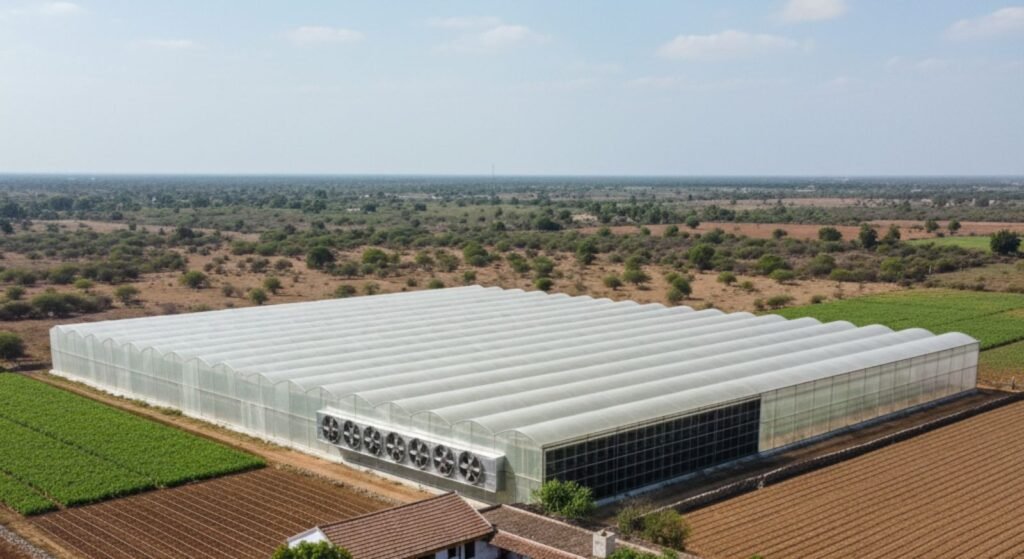Introduction
Agriculture is no longer only about the farmer’s intuition or traditional methods passed down for generations. Today, farming is entering a new era—an era of data, automation, and smart technologies. Protected cultivation through polyhouses, greenhouses, and shade nets has already given farmers better control over the environment. But now, with tools like IoT (Internet of Things), sensors, and automation, farmers can manage their crops with precision that was once unimaginable.
This blog explores how smart farming technologies are reshaping protected cultivation in India and why they are set to play a crucial role in the future of agriculture.
Why Protected Cultivation Needs Technology
While polyhouses and shade nets protect crops from weather, they also create a microclimate that needs to be carefully managed. For example:
- Too much humidity can trigger fungal diseases.
- Uneven temperature can affect fruit setting.
- Over-irrigation wastes water and increases costs.
Traditionally, farmers would make manual adjustments—opening vents, running pumps, or guessing when to irrigate. But human judgment isn’t always precise, especially when dealing with delicate crops like capsicum, strawberries, or roses.
This is where smart farming technology comes in.
The Role of IoT and Sensors
1. Climate Monitoring
Sensors installed inside a polyhouse can continuously track temperature, humidity, and light levels. This data is sent to the farmer’s smartphone in real time, helping them decide when to open vents, turn on cooling systems, or add shade.
2. Soil Moisture & Irrigation Control
Moisture sensors ensure crops receive just the right amount of water. If the soil gets too dry, the system automatically triggers drip irrigation. This prevents both water stress and wastage.
3. Fertigation Management
With automated fertigation units, nutrients can be delivered through irrigation with exact measurements. Farmers don’t have to rely on guesswork—plants get what they need, when they need it.
4. Disease and Pest Prediction
Some advanced systems use sensor data to predict conditions where pests or diseases are likely to appear. This allows preventive action, reducing pesticide use.
Automation in Action
- Ventilation: Roofs or side curtains of polyhouses can open automatically based on temperature readings.
- Foggers and Misters: Can turn on when humidity drops below a set level.
- Shade Systems: In high-end greenhouses, shades can roll over automatically when sunlight intensity is too high.
The result is a self-regulating farm environment where human effort is reduced, and plant growth conditions are always optimized.
Benefits for Farmers
- Higher Yields: With better control of climate and nutrients, crops grow faster and healthier.
- Water Efficiency: Smart irrigation reduces water use by 30–40%.
- Lower Input Costs: Fertilizer and pesticide use becomes more efficient.
- Reduced Risk: By predicting stress conditions, farmers avoid sudden losses.
- Ease of Management: Even if the farmer is away, the system can be monitored and controlled remotely.
Real-World Example
In Maharashtra, a farmer growing gerbera flowers in a climate-controlled polyhouse installed IoT sensors and automated fertigation. Within one season, he reported:
- 25% increase in flower production
- Reduced fertilizer use by 20%
- Better consistency in flower size and quality, fetching higher market prices
This shows that even though technology requires initial investment, the returns can be substantial.
Challenges Ahead
- Cost: Advanced automation systems can be expensive for small farmers.
- Training: Farmers need guidance to operate and maintain IoT-based systems.
- Connectivity: Remote areas with weak internet may face difficulties in real-time monitoring.
However, as technology becomes cheaper and more accessible, these challenges will reduce. Government support and agri-tech startups are already working to bridge the gap.
The Future of Smart Farming
Protected cultivation is only the beginning. In the future, we may see:
- AI-powered crop management that gives recommendations directly to farmers.
- Drones monitoring crop health and spraying with precision.
- Blockchain-linked supply chains where buyers can trace the journey of produce from farm to market.
For India, where food security and farmer income are critical, adopting smart farming within protected structures could be the turning point.
Conclusion
Smart farming technologies are not about replacing the farmer—they are about empowering them. With sensors, automation, and IoT, farmers can make informed decisions, reduce waste, and produce crops of consistent quality. Protected cultivation combined with smart technology is no longer just an option—it is the future of agriculture.

